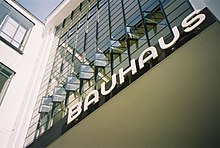
Back Bauhaus Afrikaans Bauhaus ALS باوهاوس Arabic باوهاوس ARZ Escuela de la Bauhaus AST Bauhauz Azerbaijani Bauhaus BAR Баўгауз Byelorussian Баухаус Bulgarian বাউহাউস Bengali/Bangla
You can help expand this article with text translated from the corresponding article in Hebrew. Click [show] for important translation instructions.
|
| UNESCO World Heritage Site | |
|---|---|
 The Bauhaus building in Dessau was designed by Walter Gropius. It was the longest-serving of the three Bauhaus locations (1925–1932). | |
| Location | Germany |
| Criteria | Cultural: ii, iv, vi |
| Reference | 729 |
| Inscription | 1996 (20th Session) |
| Area | 8.1614 ha (20.167 acres) |
| Buffer zone | 59.26 ha (146.4 acres) |


The Staatliches Bauhaus (German: [ˈʃtaːtlɪçəs ˈbaʊˌhaʊs] ⓘ), commonly known as the Bauhaus (German for 'building house'), was a German art school operational from 1919 to 1933 that combined crafts and the fine arts.[1] The school became famous for its approach to design, which attempted to unify individual artistic vision with the principles of mass production and emphasis on function.[1] Along with the doctrine of functionalism, the Bauhaus initiated the conceptual understanding of architecture and design.[2]
The Bauhaus was founded by architect Walter Gropius in Weimar. It was grounded in the idea of creating a Gesamtkunstwerk ("comprehensive artwork") in which all the arts would eventually be brought together. The Bauhaus style later became one of the most influential currents in modern design, modernist architecture, and architectural education.[3] The Bauhaus movement had a profound influence on subsequent developments in art, architecture, graphic design, interior design, industrial design, and typography.[4] Staff at the Bauhaus included prominent artists such as Paul Klee, Wassily Kandinsky, Gunta Stölzl, and László Moholy-Nagy at various points.

The school existed in three German cities—Weimar, from 1919 to 1925; Dessau, from 1925 to 1932; and Berlin, from 1932 to 1933—under three different architect-directors: Walter Gropius from 1919 to 1928; Hannes Meyer from 1928 to 1930; and Ludwig Mies van der Rohe from 1930 until 1933, when the school was closed by its own leadership under pressure from the Nazi regime, having been painted as a centre of communist intellectualism.[5] Internationally, former key figures of Bauhaus were successful in the United States and became known as the avant-garde for the International Style.[6]
The changes of venue and leadership resulted in a constant shifting of focus, technique, instructors, and politics. For example, the pottery shop was discontinued when the school moved from Weimar to Dessau, even though it had been an important revenue source; when Mies van der Rohe took over the school in 1930, he transformed it into a private school and would not allow any supporters of Hannes Meyer to attend it.
- ^ a b Oxford Dictionary of Art and Artists (Oxford: Oxford University Press, 4th edn., 2009), ISBN 0-19-953294-X, pp. 64–66
- ^ Vasileva E. (2016) Ideal and utilitarian in the international style system: subject and object in the design concept of the 20th century // International Journal of Cultural Research, 4 (25), 72–80.
- ^ Pevsner, Nikolaus, ed. (1999). A Dictionary of Architecture and Landscape Architecture (Paperback). Fleming, John; Honour, Hugh (5th ed.). London: Penguin Books. p. 880. ISBN 978-0-14-051323-3.
- ^ "Bauhaus Movement". Rethinking the world Art and Technology – A new Unity.
- ^ Barnes, Rachel (2001). The 20th-Century art book (Reprinted. ed.). London: Phaidon Press. ISBN 978-0-7148-3542-6.
- ^ Routledge international handbook of participatory design. Jesper Simonsen, Toni Robertson. New York: Routledge. 2013. p. 38. ISBN 978-0-415-69440-7. OCLC 754734489.
{{cite book}}: CS1 maint: others (link)
© MMXXIII Rich X Search. We shall prevail. All rights reserved. Rich X Search
